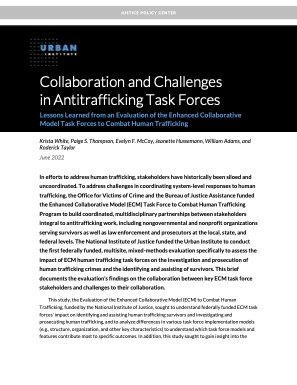By Leah Sakala, Krista White, Constance Hull
Stable employment is associated with significant short- and long-term benefits for youth and young adults (ages 16 to 24), but juvenile or criminal legal system involvement can create significant employment barriers, especially for young people (Ross et al. 2018; Weber 2021). 1 Engaging with supportive services in a communitybasedEngage employers as a key constituency for fostering participants’ success, focusing on employer fit—including employers’ willingness to change their practices to better retain employees and troubleshoot challenges. Collaborate with other local service providers to provide complementary services and engage in cross-referrals. setting can help young people navigate and mitigate these barriers by accessing support to meet basic needs and set and achieve professional goals (Blum et al. 2021; De Nike et al. 2019). This report summarizes findings from an exploratory study of community-based workforce development programs that involved a nationwide survey and a series of 15 follow-up interviews with staff members from a subset of surveyed programs serving youth and young adults who have been adjudicated for or convicted of serious offenses. The programs we examined use a variety of strategies to serve their participants, including engaging in multisector partnerships, offering a wide range of workforce- and non-workforce-related supports, blending funding from multiple sources, and measuring progress and success. Though many programs are actively serving system-involved young people, they varied as to the extent to which services were tailored for this population. Our findings highlight the importance of providing flexible service models that can be adapted to meet participants’ unique needs, particularly as they pertain to the barriers associated with legal system involvement and the young adult life stage. By developing a responsive program structure, building the organizational infrastructure to support program success, and engaging in strategic partnerships and collaborations, community-based programs can help young people involved in the legal system overcome barriers and identify and meet their employment and career goals. Key Findings and Considerations for Stakeholders Providing flexible and holistic services that meet the employment and career needs of young people with criminal records requires designing programs intentionally, building and sustaining a supportive organizational infrastructure, and coordinating across a wide range of partners including employers and legal system stakeholders. Key considerations for intentionally designing programs to facilitate workforce engagement among young people with criminal records include the following: ◼ Use an individualized, developmentally appropriate, and strength-based approach, including by collaborating with participants to identify resources and goals and allowing for extended engagement with participants if desired. ◼ Understand participants’ experiences with trauma and mental health challenges and adjust program offerings and services accordingly. ◼ Offer wraparound support to foster successful workforce engagement, including by ensuring participants can meet their basic needs, such as child care, stable housing, food security, and mental health. ◼ Engage with participants on the nature of their legal system involvement to help them overcome related barriers. This can include helping them understand their criminal records, supporting them with complying with community supervision requirements, or addressing outstanding fines and fees. ◼ Tailor programs to meet the needs of specific participant subpopulations, including by collaborating with other community-based providers with complementary offerings. Key considerations for building and sustaining a supportive organizational infrastructure include the following: ◼ Support a wider and more flexible array of service offerings by using a blended funding model that leverages resources from different sources (such as a mix of federal and philanthropic grants). ◼ Hire staff with similar life experiences as participants—such as juvenile or criminal legal system involvement, shared cultural and language backgrounds, shared neighborhood and community membership, experiences with systemic racism, and experiences with class and poverty—and provide staff training on positive youth development strategies and trauma-informed care. ◼ Address any gaps in data collection strategies that may limit practice and outcome documentation. Key considerations for coordination across partners include the following: ◼ Engage with legal system actors, whether through formal collaboration or more informal relationship-building efforts
Washington DC: Urban Institute, 2022. 50p.





















